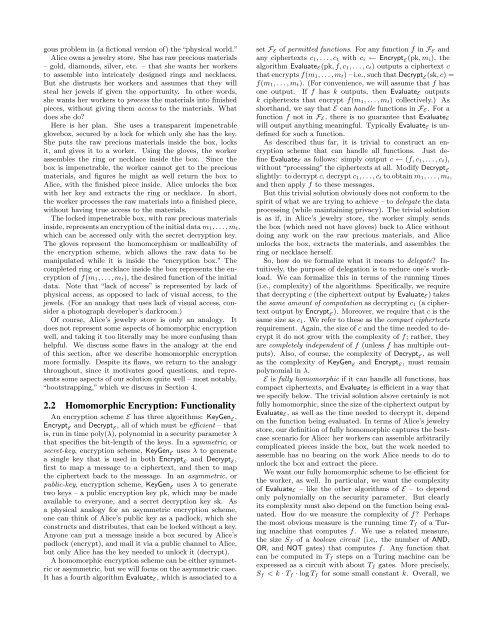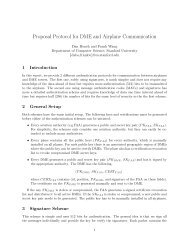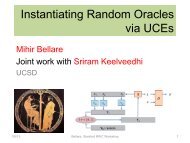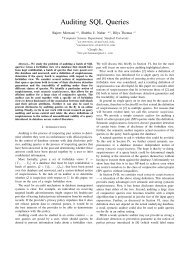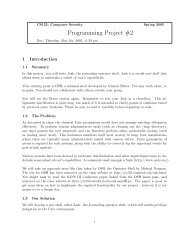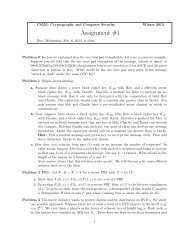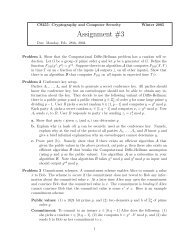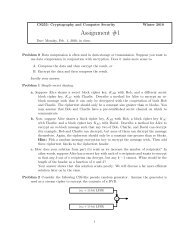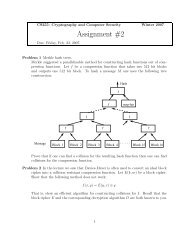Computing Arbitrary Functions of Encrypted Data - Stanford Crypto ...
Computing Arbitrary Functions of Encrypted Data - Stanford Crypto ...
Computing Arbitrary Functions of Encrypted Data - Stanford Crypto ...
Create successful ePaper yourself
Turn your PDF publications into a flip-book with our unique Google optimized e-Paper software.
gous problem in (a fictional version <strong>of</strong>) the “physical world.”<br />
Alice owns a jewelry store. She has raw precious materials<br />
– gold, diamonds, silver, etc. – that she wants her workers<br />
to assemble into intricately designed rings and necklaces.<br />
But she distrusts her workers and assumes that they will<br />
steal her jewels if given the opportunity. In other words,<br />
she wants her workers to process the materials into finished<br />
pieces, without giving them access to the materials. What<br />
does she do?<br />
Here is her plan. She uses a transparent impenetrable<br />
glovebox, secured by a lock for which only she has the key.<br />
She puts the raw precious materials inside the box, locks<br />
it, and gives it to a worker. Using the gloves, the worker<br />
assembles the ring or necklace inside the box. Since the<br />
box is impenetrable, the worker cannot get to the precious<br />
materials, and figures he might as well return the box to<br />
Alice, with the finished piece inside. Alice unlocks the box<br />
with her key and extracts the ring or necklace. In short,<br />
the worker processes the raw materials into a finished piece,<br />
without having true access to the materials.<br />
The locked impenetrable box, with raw precious materials<br />
inside, represents an encryption <strong>of</strong> the initial data m1, . . . , mt,<br />
which can be accessed only with the secret decryption key.<br />
The gloves represent the homomorphism or malleability <strong>of</strong><br />
the encryption scheme, which allows the raw data to be<br />
manipulated while it is inside the “encryption box.” The<br />
completed ring or necklace inside the box represents the encryption<br />
<strong>of</strong> f(m1, . . . , mt), the desired function <strong>of</strong> the initial<br />
data. Note that “lack <strong>of</strong> access” is represented by lack <strong>of</strong><br />
physical access, as opposed to lack <strong>of</strong> visual access, to the<br />
jewels. (For an analogy that uses lack <strong>of</strong> visual access, consider<br />
a photograph developer’s darkroom.)<br />
Of course, Alice’s jewelry store is only an analogy. It<br />
does not represent some aspects <strong>of</strong> homomorphic encryption<br />
well, and taking it too literally may be more confusing than<br />
helpful. We discuss some flaws in the analogy at the end<br />
<strong>of</strong> this section, after we describe homomorphic encryption<br />
more formally. Despite its flaws, we return to the analogy<br />
throughout, since it motivates good questions, and represents<br />
some aspects <strong>of</strong> our solution quite well – most notably,<br />
“bootstrapping,” which we discuss in Section 4.<br />
2.2 Homomorphic Encryption: Functionality<br />
An encryption scheme E has three algorithms: KeyGen E,<br />
Encrypt E and Decrypt E , all <strong>of</strong> which must be efficient – that<br />
is, run in time poly(λ), polynomial in a security parameter λ<br />
that specifies the bit-length <strong>of</strong> the keys. In a symmetric, or<br />
secret-key, encryption scheme, KeyGen E uses λ to generate<br />
a single key that is used in both Encrypt E and Decrypt E ,<br />
first to map a message to a ciphertext, and then to map<br />
the ciphertext back to the message. In an asymmetric, or<br />
public-key, encryption scheme, KeyGen E uses λ to generate<br />
two keys – a public encryption key pk, which may be made<br />
available to everyone, and a secret decryption key sk. As<br />
a physical analogy for an asymmetric encryption scheme,<br />
one can think <strong>of</strong> Alice’s public key as a padlock, which she<br />
constructs and distributes, that can be locked without a key.<br />
Anyone can put a message inside a box secured by Alice’s<br />
padlock (encrypt), and mail it via a public channel to Alice,<br />
but only Alice has the key needed to unlock it (decrypt).<br />
A homomorphic encryption scheme can be either symmetric<br />
or asymmetric, but we will focus on the asymmetric case.<br />
It has a fourth algorithm EvaluateE, which is associated to a<br />
set FE <strong>of</strong> permitted functions. For any function f in FE and<br />
any ciphertexts c1, . . . , ct with ci ← Encrypt E(pk, mi), the<br />
algorithm EvaluateE(pk, f, c1, . . . , ct) outputs a ciphertext c<br />
that encrypts f(m1, . . . , mt) – i.e., such that Decrypt E (sk, c) =<br />
f(m1, . . . , mt). (For convenience, we will assume that f has<br />
one output. If f has k outputs, then EvaluateE outputs<br />
k ciphertexts that encrypt f(m1, . . . , mt) collectively.) As<br />
shorthand, we say that E can handle functions in FE. For a<br />
function f not in FE, there is no guarantee that EvaluateE<br />
will output anything meaningful. Typically EvaluateE is undefined<br />
for such a function.<br />
As described thus far, it is trivial to construct an encryption<br />
scheme that can handle all functions. Just define<br />
EvaluateE as follows: simply output c ← (f, c1, . . . , ct),<br />
without “processing” the ciphertexts at all. Modify Decrypt E<br />
slightly: to decrypt c, decrypt c1, . . . , ct to obtain m1, . . . , mt,<br />
and then apply f to these messages.<br />
But this trivial solution obviously does not conform to the<br />
spirit <strong>of</strong> what we are trying to achieve – to delegate the data<br />
processing (while maintaining privacy). The trivial solution<br />
is as if, in Alice’s jewelry store, the worker simply sends<br />
the box (which need not have gloves) back to Alice without<br />
doing any work on the raw precious materials, and Alice<br />
unlocks the box, extracts the materials, and assembles the<br />
ring or necklace herself.<br />
So, how do we formalize what it means to delegate? Intuitively,<br />
the purpose <strong>of</strong> delegation is to reduce one’s workload.<br />
We can formalize this in terms <strong>of</strong> the running times<br />
(i.e., complexity) <strong>of</strong> the algorithms. Specifically, we require<br />
that decrypting c (the ciphertext output by EvaluateE) takes<br />
the same amount <strong>of</strong> computation as decrypting c1 (a ciphertext<br />
output by Encrypt E ). Moreover, we require that c is the<br />
same size as c1. We refer to these as the compact ciphertexts<br />
requirement. Again, the size <strong>of</strong> c and the time needed to decrypt<br />
it do not grow with the complexity <strong>of</strong> f; rather, they<br />
are completely independent <strong>of</strong> f (unless f has multiple outputs).<br />
Also, <strong>of</strong> course, the complexity <strong>of</strong> Decrypt E , as well<br />
as the complexity <strong>of</strong> KeyGen E and Encrypt E, must remain<br />
polynomial in λ.<br />
E is fully homomorphic if it can handle all functions, has<br />
compact ciphertexts, and EvaluateE is efficient in a way that<br />
we specify below. The trivial solution above certainly is not<br />
fully homomorphic, since the size <strong>of</strong> the ciphertext output by<br />
EvaluateE, as well as the time needed to decrypt it, depend<br />
on the function being evaluated. In terms <strong>of</strong> Alice’s jewelry<br />
store, our definition <strong>of</strong> fully homomorphic captures the bestcase<br />
scenario for Alice: her workers can assemble arbitrarily<br />
complicated pieces inside the box, but the work needed to<br />
assemble has no bearing on the work Alice needs to do to<br />
unlock the box and extract the piece.<br />
We want our fully homomorphic scheme to be efficient for<br />
the worker, as well. In particular, we want the complexity<br />
<strong>of</strong> EvaluateE – like the other algorithms <strong>of</strong> E – to depend<br />
only polynomially on the security parameter. But clearly<br />
its complexity must also depend on the function being evaluated.<br />
How do we measure the complexity <strong>of</strong> f? Perhaps<br />
the most obvious measure is the running time Tf <strong>of</strong> a Turing<br />
machine that computes f. We use a related measure,<br />
the size Sf <strong>of</strong> a boolean circuit (i.e., the number <strong>of</strong> AND,<br />
OR, and NOT gates) that computes f. Any function that<br />
can be computed in Tf steps on a Turing machine can be<br />
expressed as a circuit with about Tf gates. More precisely,<br />
Sf < k · Tf · log Tf for some small constant k. Overall, we


